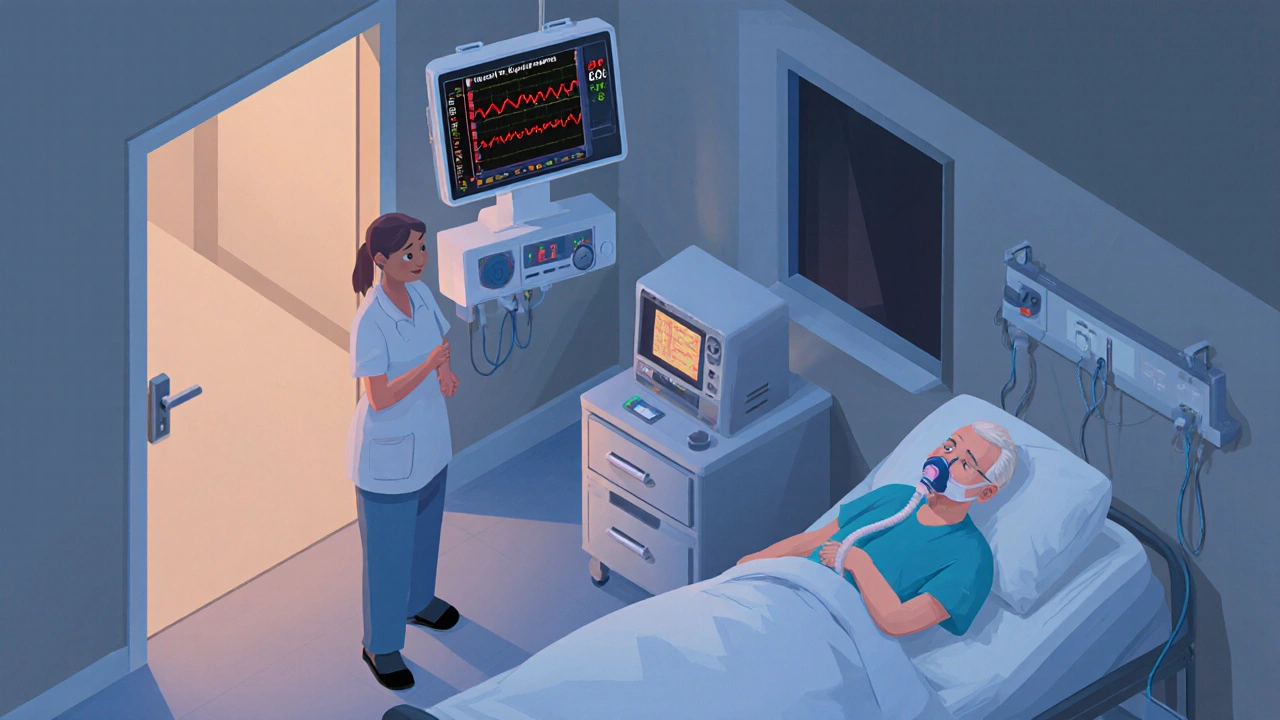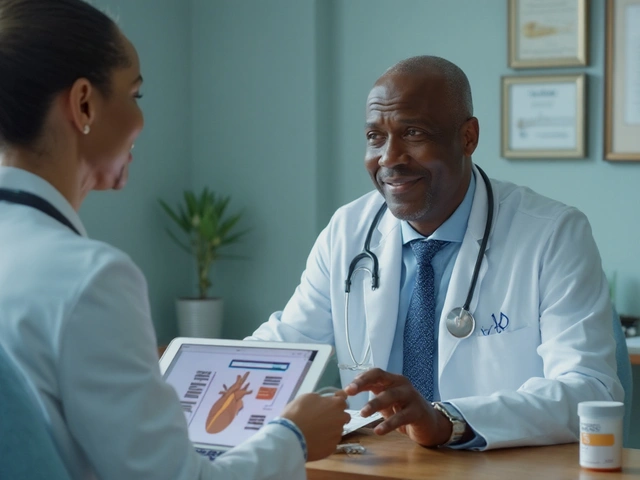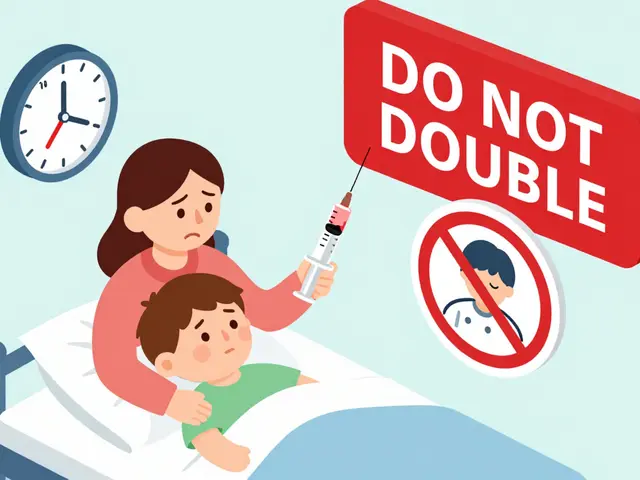Respiratory Depression from Opioids and Other Medications: Critical Signs You Can't Ignore

Opioid Respiratory Depression Risk Calculator
Personal Risk Assessment
This tool calculates your risk of opioid-induced respiratory depression based on medical factors from the latest research. Remember: this is for informational purposes only. Always consult your healthcare provider.
Your Risk Assessment
What to Do Next
When someone takes too much of an opioid-or combines it with another sedative-their breathing can slow down until it stops. This isn’t rare. It’s not just a drug problem. It happens in hospitals, at home, and even after a routine surgery. Respiratory depression from opioids is the leading cause of preventable death after surgery in the U.S., and it’s often missed because the signs don’t look like what people expect.
What Respiratory Depression Actually Looks Like
Most people think of overdose as someone slumped over, unresponsive, with blue lips. But respiratory depression starts quietly. It begins with a breathing rate dropping below 10 breaths per minute. Then it slips to 8, then 6. Each breath gets shallower. The person may seem sleepy, confused, or just "out of it." They might not even respond when you shake them gently.
The real danger? Oxygen levels can stay normal for a while-especially if they’re on supplemental oxygen. That’s because oxygen masks hide the real problem: carbon dioxide building up in the blood. When CO₂ hits 50 mmHg or higher, the brain stops triggering breaths. The body is essentially suffocating while still getting air from a mask. This is why pulse oximetry alone isn’t enough.
Studies show that in over 70% of fatal cases, the first warning signs were missed because staff were checking vital signs only every 4 hours. That means a patient could go from normal breathing to respiratory arrest in less than 30 minutes and go unnoticed for hours.
Who’s at Highest Risk?
Not everyone who takes opioids will have this reaction. But some people are far more vulnerable.
- People over 60: Their bodies process drugs slower, and their breathing control weakens with age.
- Those who’ve never taken opioids before: Opioid-naïve patients are 4.5 times more likely to develop respiratory depression than those used to the drugs.
- Women: They have a 1.7 times higher risk than men, even at the same dose.
- People with multiple health problems: Each additional condition-like sleep apnea, COPD, or heart failure-doubles the risk.
- Anyone mixing opioids with benzodiazepines, alcohol, or sleep aids: This combo increases the chance of respiratory depression by nearly 15 times.
One study found that patients on both an opioid and a benzodiazepine were 6.3 times more likely to need naloxone than those on opioids alone. And in real-world hospitals, nearly half of all respiratory depression cases happen in patients prescribed both types of drugs.
The Silent Signs (Beyond Slow Breathing)
Slow breathing is the only universal sign. But other clues often appear before breathing becomes dangerously slow:
- Extreme tiredness or lethargy (78% of cases)
- Confusion or disorientation (53%)
- Nausea and vomiting (65%)
- Headache (42%)
- Dizziness or lightheadedness (29%)
- Faster heart rate (tachycardia in 37% of cases)
These symptoms are often mistaken for side effects of pain meds or just "being groggy." But when they show up together-especially with shallow breaths-they’re red flags. A patient who’s normally alert but suddenly can’t answer simple questions like "What day is it?" is already in trouble.

How Hospitals Are Trying to Stop It
Some hospitals are making real progress. The ones that use continuous monitoring-instead of hourly checks-have cut respiratory depression cases by nearly half.
Two tools make the biggest difference:
- Capnography: Measures carbon dioxide levels in exhaled breath. It’s 94% accurate at catching breathing problems, even when oxygen is being given.
- Pulse oximetry: Tracks oxygen levels. Still useful, but only when no oxygen is being added. With oxygen, it can miss rising CO₂.
Advanced systems now combine both, along with AI that predicts breathing failure 15 minutes before it happens. These tools are in use at top hospitals-but only 22% of U.S. hospitals use them fully. Community hospitals? Only 14% have full protocols.
Other effective strategies:
- Pharmacist-led opioid dosing: Pharmacists review all prescriptions before giving opioids, especially for high-risk patients.
- Mandatory staff training: Nurses who’ve been trained to spot early signs catch problems 68% faster than those who haven’t.
- 2-hour post-dose monitoring: After the first dose of an opioid, high-risk patients are checked every 15 minutes for two hours.
What You Can Do at Home
If you or a loved one is taking opioids at home, don’t assume it’s safe just because the doctor prescribed it.
- Know the signs: Slow breathing (less than 10 breaths per minute), unresponsiveness, blue lips or fingertips.
- Never mix opioids with alcohol, sleeping pills, or anti-anxiety meds.
- Ask your doctor: "Is this dose right for someone who’s never taken opioids before?" If they say "yes" without checking your history, get a second opinion.
- Keep naloxone on hand: It reverses opioid overdose. It’s safe, easy to use, and available without a prescription in most states.
- Set alarms: If someone is on a new opioid, check their breathing every hour for the first 4 hours. Use your phone. Don’t rely on memory.
One family in Ohio saved their 72-year-old father’s life after he started taking oxycodone for back pain. He was sleepy, but they didn’t think much of it-until they noticed his breathing dropped to 6 breaths per minute. They gave him naloxone. He woke up. He’s alive because they knew what to look for.

Why Naloxone Isn’t a Cure-All
Naloxone can bring someone back from the edge. But it’s not perfect.
It wears off faster than most opioids. So a person might wake up, breathe again, and then slip back into respiratory depression hours later. That’s why anyone who gets naloxone needs to be monitored for at least 2 hours after the last dose.
In cancer patients, naloxone can suddenly take away their pain relief. That’s why doctors have to titrate it carefully-give small doses, watch the response, and stop once breathing improves.
And naloxone doesn’t help if the overdose comes from non-opioid drugs like benzodiazepines or barbiturates. That’s why understanding what’s in the system matters.
The Bigger Picture
Respiratory depression from opioids isn’t just a medical issue. It’s a system failure. The U.S. spends $1.2 billion a year treating preventable cases. Medicare and Medicaid now classify severe respiratory depression as a "never event"-meaning hospitals get penalized if it happens.
But penalties alone won’t fix this. Training will. Monitoring will. Awareness will.
The future is coming. In 2023, the FDA approved an opioid risk calculator that uses 12 patient factors to predict who’s most likely to have breathing trouble. It’s 84% accurate. But only a handful of hospitals use it yet.
What’s clear? If you’re caring for someone on opioids, you’re not just a family member-you’re a lifeline. You don’t need to be a nurse. You just need to know what to look for.
Can someone have respiratory depression without seeming drunk or high?
Yes. Many people assume respiratory depression only happens to people who look intoxicated. But it often occurs in patients who are calm, quiet, and even cooperative. The key signs are slow, shallow breathing and reduced responsiveness-not slurred speech or erratic behavior.
Is pulse oximetry enough to detect opioid-induced respiratory depression?
No, not when supplemental oxygen is being used. Pulse oximetry measures oxygen in the blood, but it can stay normal even as carbon dioxide builds up dangerously. Capnography, which measures exhaled CO₂, is far more reliable in these cases. For patients not on oxygen, pulse oximetry is still useful-but it should never be the only tool.
How fast does respiratory depression happen after taking an opioid?
It can happen within minutes after an IV dose, or within 30 to 90 minutes after an oral dose. For people who’ve never taken opioids before, the risk is highest in the first 2 to 4 hours. That’s why monitoring right after the first dose is critical.
Can you become immune to respiratory depression from opioids?
You can develop tolerance to the pain-relieving effects, but not to the respiratory depression. Even long-term opioid users can suddenly experience dangerous breathing suppression if they take a higher dose, mix it with other drugs, or become sick. Tolerance is not protection.
What should I do if I suspect someone is having respiratory depression?
Call 911 immediately. If you have naloxone, administer it right away. Try to keep the person awake and in a position where their airway is open-on their side if they’re unconscious. Don’t wait for symptoms to get worse. Early action saves lives.
Are there new medications that don’t cause respiratory depression?
Researchers are developing biased mu-opioid receptor agonists that relieve pain without suppressing breathing. These are in Phase III clinical trials and show promise, but they’re not available to the public yet. For now, the safest approach is careful dosing, monitoring, and avoiding combinations with other sedatives.
Final Thought: It’s Preventable
Respiratory depression from opioids doesn’t have to be fatal. It’s not an accident waiting to happen-it’s a warning sign that’s been ignored too many times. The tools to stop it exist. The knowledge is out there. What’s missing is consistent action.
If you’re a patient, ask questions. If you’re a caregiver, watch closely. If you’re a healthcare worker, don’t rely on hourly checks. Use the tools you have. Push for better systems. Because every breath matters-and sometimes, noticing one slow breath is the only thing that stands between life and death.






Comments (16)
Dion Hetemi
19 Nov 2025
Let me tell you, I’ve seen this play out in the ER more times than I can count. A guy comes in after his hip surgery, on oxycodone, oxygen mask on, pulse ox at 98%-looks fine. Then he stops breathing. No snoring, no thrashing. Just… gone. Capnography saved his life. Why aren’t we using it everywhere? It’s not fancy tech-it’s basic. Hospitals are still playing Russian roulette with patients’ lives because of cost-cutting. Wake up.
Brian Rono
19 Nov 2025
Let’s be brutally honest: this isn’t about ‘system failure.’ It’s about lazy medicine. Doctors prescribe opioids like they’re candy because they’re too rushed to figure out alternatives. Nurses check vitals every four hours because they’re understaffed and overworked. And patients? They’re told to ‘just take it easy.’ Meanwhile, CO₂ builds up like a ticking bomb, and everyone’s too busy scrolling through TikTok to notice. The real problem isn’t the drug-it’s the culture of negligence wrapped in white coats.
seamus moginie
20 Nov 2025
While I deeply appreciate the clinical precision of this piece, I must express my profound concern regarding the systemic underutilization of capnography. In Ireland, we have mandated continuous monitoring in post-op wards since 2020. The reduction in adverse events has been statistically significant. Why does the U.S. lag so far behind? Is it bureaucracy? Profit? Or simply a failure of moral imagination? We must do better.
Dana Dolan
20 Nov 2025
My grandma was on opioids after her knee surgery. She was so quiet, we thought she was just resting. Then I noticed her breaths were like… every 10 seconds. I called the nurse. They said it was normal. I insisted. They checked. She was dropping CO2. They gave her naloxone. She’s fine now. But I almost didn’t catch it. Please, if you’re caring for someone on these meds-watch their breathing. Not their face. Not their pulse. Their BREATHING.
Zac Gray
22 Nov 2025
Look, I get it. Opioids are powerful. But let’s not turn every patient into a ticking time bomb. The real tragedy isn’t the drug-it’s that we’ve outsourced vigilance to machines while pretending we’re still caring for humans. If you’re not checking on someone every 30 minutes for the first 4 hours after a new opioid dose, you’re not a caregiver-you’re a bystander. And yes, I’m talking to you, hospital admins who think ‘hourly checks’ are good enough. They’re not. They’re a death sentence waiting for paperwork.
Steve and Charlie Maidment
23 Nov 2025
So let me get this straight-you’re telling me we’ve known for years that pulse oximetry is useless when oxygen is on, yet we still use it as the gold standard? And we wonder why people die? This isn’t medical negligence. This is institutional arrogance. We’ve got AI that can predict breathing failure 15 minutes out, but hospitals won’t spend $500 per bed on capnography because ‘it’s not budgeted.’ Meanwhile, families are burying loved ones who didn’t need to die. The system isn’t broken. It’s designed this way.
Michael Petesch
25 Nov 2025
Interesting how this article emphasizes cultural and demographic risk factors-age, sex, comorbidities-but says nothing about socioeconomic disparities. Patients in rural hospitals, or those without insurance, are far less likely to receive even basic monitoring. Naloxone is available OTC, but if you can’t afford the device to administer it properly-or don’t have someone home to watch you-what good is it? This isn’t just a clinical issue. It’s a justice issue.
Ellen Calnan
26 Nov 2025
I lost my brother to this. He was 41. Had a hernia repair. Prescribed hydrocodone. Took one pill. Slept. Didn’t wake up. They said it was ‘unforeseen.’ But the signs were there-he was lethargic, his skin was clammy, his lips were pale. We thought he was just tired. We didn’t know what to look for. If someone had told us that breathing less than 10 times a minute meant danger-if someone had said, ‘check his breaths like you’re counting stars’-he’d be here. Please. Don’t let your silence be their last memory.
Richard Risemberg
26 Nov 2025
Let me tell you something most hospitals won’t admit: the opioid crisis didn’t start on the streets-it started in the OR. We overprescribed because we were scared of patient complaints. We called it ‘pain management.’ It was control. And now we’re paying the price with lives. But here’s the good news-we can fix it. Capnography. Training. Pharmacists on rounds. Two-hour monitoring. It’s not magic. It’s just… doing your damn job. And if you’re not doing it, get out of the room.
Andrew Montandon
28 Nov 2025
Wait-so you’re telling me that in 2025, we still don’t have mandatory capnography in all post-op units? And that nurses aren’t trained to recognize CO2 buildup before it’s too late? And that families aren’t given a printed checklist of warning signs before discharge? This isn’t just a gap in care-it’s a moral failure. We have the tools. We have the data. We have the will. What we don’t have is the courage to demand change. So I’m demanding it. Now. And I’m not stopping until every hospital in this country has a sign on every bed: ‘BREATHE. WATCH. ACT.’
Sam Reicks
29 Nov 2025
Big Pharma paid off the FDA and the AMA to push opioids as safe. They knew about respiratory depression. They buried the studies. Now they’re selling naloxone like it’s a band-aid for their crime. And the government lets them. Why? Because they’re rich. And we’re just numbers. This isn’t medicine-it’s a scam. They want you to think it’s your fault for taking the pill. But it’s their fault for selling it. And they’re still doing it. Look at the new ‘safer’ opioids-same mechanism. Same risk. Same profit. Wake up.
Chuck Coffer
29 Nov 2025
Oh wow. Another article blaming hospitals for not doing their job. Meanwhile, patients are popping pills like candy and expecting miracles. If you can’t handle a little pain, maybe you shouldn’t be on opioids. And if your family member is sleeping too much? Maybe they just need to toughen up. This is why America’s dying-everyone wants a trophy for breathing.
Marjorie Antoniou
1 Dec 2025
This hit me hard. My sister’s a nurse in a small ER. She told me about a patient who coded because no one checked his breathing after his first dose. She cried for days. I asked her what changed. She said, ‘We started doing 15-minute checks after the first dose. We started asking families to count breaths.’ It’s not rocket science. It’s just… showing up. Thank you for reminding us that we can be the difference.
Andrew Baggley
2 Dec 2025
One breath. That’s all it takes. One slow breath. One moment where you say, ‘That’s not right.’ And you act. No waiting. No second-guessing. You don’t need a medical degree. You just need to care enough to count. I keep a little notepad in my wallet now. Every time my dad takes his pain meds, I write down the time and count his breaths. It’s not much. But it’s everything.
Codie Wagers
2 Dec 2025
Respiratory depression is a myth invented by the pharmaceutical-industrial complex to sell more monitoring equipment. Opioids don’t kill people-poor lifestyle choices do. If you’re mixing meds, drinking, and sleeping alone, you’re asking for trouble. The real tragedy? We’ve turned a personal responsibility into a systemic crisis so we can feel better about our own complacency. Stop blaming hospitals. Start blaming people who don’t know how to take a pill.
Zac Gray
3 Dec 2025
And yet, despite all this, we still have doctors who say, ‘It’s fine, he’s on oxygen.’ That’s not safety. That’s delusion. I’ve seen it. A man on 4L of oxygen, breathing at 5 per minute, and the nurse says, ‘He’s stable.’ Stable? He’s a corpse with a pulse. We’re not saving lives-we’re delaying funerals. And we’re proud of it.